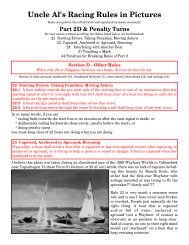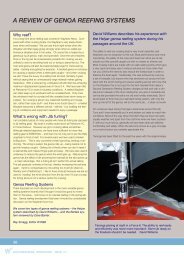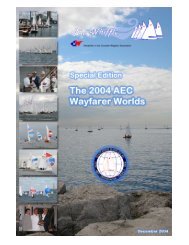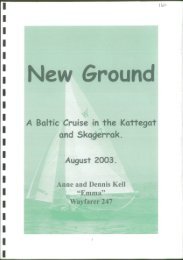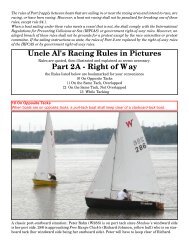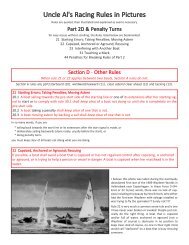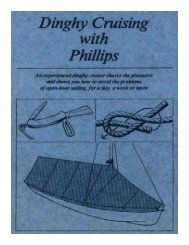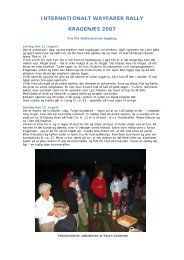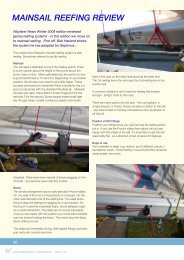NOAA #12230: Crisfield - Smith Island (p.13-14), etc.
NOAA #12230: Crisfield - Smith Island (p.13-14), etc.
NOAA #12230: Crisfield - Smith Island (p.13-14), etc.
- No tags were found...
You also want an ePaper? Increase the reach of your titles
YUMPU automatically turns print PDFs into web optimized ePapers that Google loves.
UPPEMERGENCY INFORMATIONUVHF Marine Radio channels for use on the waterways:Channel 6 – Intership safety communications.Channel 9 – Communications between boats andship-to-coast.Channel 13 – Navigation purposes at bridges, locks,harbors.Channel 16 – Emergency, distress and safety callsto Coast Guard and others, and to initiate calls to othervessels. Contact the other vessel, agree to anotherchannel, and then switch.Channel 22 – Calls between the Coast Guard and thepublic. Severe weather warnings, hazards tonavigation and safety warnings are broadcast here.Channels 68, 69, 71, 72 & 78 – Recreational boatchannels.UDistress Call Procedures1. Make sure radio is on.2. Select Channel 16.3. Press/Hold the transmit button.4. Clearly say: “MAYDAY, MAYDAY, MAYDAY.”5. Also give: Vessel Name and/or Description; Positionand/or Location; Nature of Emergency; Number ofPeople on Board.6. Release transmit button.7. Wait for 10 seconds – If no response RepeatMAYDAY Call.HAVE ALL PERSONS PUT ON LIFE JACKETS !!UMobile – Call PhonesU 911 for water rescue.Coast Guard Search & Rescue – 800-418-73<strong>14</strong>/ 410-576-2525Coast Guard <strong>Crisfield</strong> – 410-968-0323Coast Guard Milford Haven – 804-725-2125/3732Coast Guard Portsmouth – 757-483-8526/8527St.Inigoes – 301-872-4344/4345Maryland Natural Resources Police – 410-260-8888Virginia Marine Police – 800-541-4646U<strong>NOAA</strong> Weather – 162.400 MHz, 162.425 MHz,RadioU162.450 MHz, 162.475 MHz, 162.500 MHz, 162.525 MHz,162.550 MHz.UGetting HelpU and Giving – Signal other boaters using visualdistress signals (flares, orange flag, lights, arm signals);whistles; horns; and on your VHF radio. You are required bylaw to help boaters in trouble. Respond to distress signals, butdo not endanger yourself..<strong>NOAA</strong> CHARTING PUBLICATIONSOfficial <strong>NOAA</strong> Nautical Charts – <strong>NOAA</strong> surveys and charts thenational and territorial waters of the U.S, including the Great Lakes,producing over 1,000 traditional nautical charts covering 3.4 millionsquare nautical miles. Carriage of official <strong>NOAA</strong> charts is mandatory onthe commercial ships that carry our commerce. They are used on everyNavy and Coast Guard ship, fishing and passenger vessels, and arewidely carried by recreational boaters. <strong>NOAA</strong> charts are available fromofficial chart agents listed at: TUwww.NauticalCharts.<strong>NOAA</strong>.gov UT.POfficial Electronic Navigational (ENCs) – ENCs areChartsPdigital files of each chart’s features and their attributes for use incomputer-based navigation systems. ENCs comply with standards of theInternational Hydrographic Organization. ENCs and their updates areavailable for free from <strong>NOAA</strong> at: TUwww.NauticalCharts.<strong>NOAA</strong>.gov UT.Official Raster Navigational Charts (RNCs) – RNCs aregeoreferenced digital pictures of <strong>NOAA</strong>’s charts that are suitable for usein computer-based navigation systems. RNCs comply with standards ofthe International Hydrographic Organization. RNCs and their updatesare available for free from <strong>NOAA</strong> at: TUwww.NauticalCharts.<strong>NOAA</strong>. gov UT.Official BookletCharts - BookletCharts are reduced scale<strong>NOAA</strong> charts printed in page-sized pieces. The “home edition” can bedownloaded from <strong>NOAA</strong> for free and printed. The “professionaledition”, containing additional boating, safety, and educational edition isavailable for <strong>NOAA</strong> chart agents or over the Internet.Official PocketCharts – PocketCharts are for beginningrecreational boaters to use for planning and locating, but not for realnavigation. Measuring a convenient 13” by 19”, they have a 1/3 scalechart on one side, and safety, boating, and educational information on thereverse. They can be purchased at retail outlets and on the Internet.®Official U.S. Coast Pilot – The Coast Pilots are 9 text volumescontaining information important to navigators such as channeldescriptions, port facilities, anchorages, bridge and cable clearances,currents, prominent features, weather, dangers, and Federal Regulations.They supplement the charts and are available from official <strong>NOAA</strong> chartagents or downloaded for free at: TUwww.NauticalCharts.<strong>NOAA</strong>.govUT.Official Print-on-Demand Nautical Charts – These full-scale<strong>NOAA</strong> charts are updated each week by <strong>NOAA</strong> for all Notice to Marinercorrections. They have additional information added in the margin tosupplement the chart. Print on Demand charts meet all federal chartcarriage regulations for charts and updating. Produced under apublic/private partnership between <strong>NOAA</strong> and OceanGrafix, LLC,suppliers of these premium charts are listed at TUwww.OceanGrafix. comUT.®Official Chart No. 1, Nautical Chart Symbols – This referencepublication depicts basic chart elements and explains nautical chartsymbols and abbreviations. Download it for free at:TUwww.NauticalCharts.<strong>NOAA</strong>.govUT.Coast Survey Navigation Manag ers – These ambassadors to themaritime community maintain a regional presence for <strong>NOAA</strong> and helpidentify the challenges facing marine transportation and boating. Theyare listed at TUhttp://nauticalcharts.noaa.gov/nsd/reps.htmUT.Internet TU si www.NauticalCharts.<strong>NOAA</strong>.govUT TUtes: , www.<strong>NOAA</strong>.govUT,TUwww.TidesandCurrents.<strong>NOAA</strong>.govUT, TUwww.NOS.<strong>NOAA</strong>.govUT.<strong>NOAA</strong>, the Nation’s Chartmaker



